What Are Dry Air & Dry Nitrogen Purges?

One of the advantages of environmental testing is the control it gives you over a workspace. You set conditions based on standards you’re testing to or the nature of the materials you’re testing. Unwanted moisture, however, can undermine your efforts, limit your chamber’s performance, and compromise data.
Some users add dry air or dry nitrogen purges to their chambers to prevent this scenario. These optional features enable you to reach extremely low relative humidity conditions and grant greater control over your testing.
What Is a Dry Air Purge?
Dry air purges force moisture out of a workspace to better control the humidity of an environment. Test chambers feature desiccant humidifiers, with active desiccant materials and hygroscopic substances that dry out anything in close proximity, and a supply of compressed air for this purpose.
Dry air purges enable you to operate tests at a much lower relative humidity (as low as 5%) than standard performance ranges. They can also help protect devices under testing (DUTs) that may be sensitive to moisture.
What is a Dry Nitrogen Purge?
Similar to dry air purges, dry nitrogen purges pull moisture out of the air within a test chamber, but, instead of using a desiccant humidifier, rely on ultra-dry nitrogen (which has a dew point of -70 degrees Celsius). When injected into an enclosed workspace, nitrogen expands and adds pressure, forcing the remaining moisture out of the chamber.
Dry nitrogen purges also prevent the oxidation of metals and reduce frost accumulation on surfaces during testing.
Keep in mind that dry air and dry nitrogen purges may struggle to remove moisture from larger workspaces, such as walk-in chambers. Manufacturers adjust by using recirculating desiccant air dryers. This involves cycling chamber air repeatedly through a desiccant air dryer before moving it back into the workspace. The captured moisture is then entirely expelled from the chamber.
Dry Air & Dry Nitrogen Use in Temperature & Humidity Test Chambers
It’s most common to find dry air and dry nitrogen purges integrated with temperature and humidity, and temperature-only test chambers.
While temperature-only chambers don’t tend to utilize humidity or water, as the name suggests, dry purges are helpful for giving engineers a higher degree of control over any moisture that may remain in the chamber.
By contrast, temperature and humidity test chambers rely heavily on water, and, conversely, dry air and nitrogen purges. Most test chambers feature dehumidification coils that help you achieve a standard relative humidity range of 20% to 95%.
Dry air and dry nitrogen purges, on the other hand, are optional features that enable you to control humidity conditions as low as 5% relative humidity.
That’s particularly important in testing to standards that require such conditions. Low humidity conditions also simulate cold, dry environments your products may encounter in the real world.
As you consider your testing options, be sure to keep an environmental test chamber manufacturer close. They can advise you on the humidity features you’ll need, including dry air or dry nitrogen purges.


